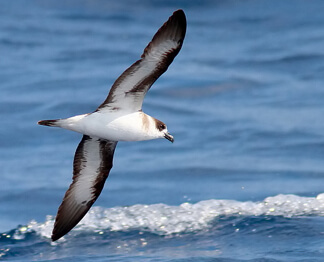Radar Tracking Project to Help Protection of Endangered Caribbean Petrel
 |
| Black-capped Petrel by Alfred Yan |
(Washington, D.C., April 29, 2013) A month-long, high-tech project to survey one of the Caribbean's most endangered birds, the Black-capped Petrel, has succeeded in identifying six previously unknown areas of petrel activity in the Dominican Republic: three flight corridors, and three possible nesting locations for the bird. Surveys also were conducted at seven sites in Haiti, a combination of new sites and areas where petrel activity was known previously.
Numbers of Black-capped Petrels have been in precipitous decline over the last 50 years with only an estimated 1,000 – 2,000 pairs remaining. Although they historically nested on other islands in the Caribbean, they are currently known to nest only on the island of Hispaniola – an Island shared by two sovereign nations, Haiti and the Dominican Republic.
Scientists hope that the surveys, which were carried out by Environmental Protection in the Caribbean (EPIC), Grupo Jaragua, and Société Audubon Haiti with support from American Bird Conservancy and the U.S. Fish and Wildlife Service, will result in the identification and better management of critical breeding locations.
Black-capped Petrels only visit their nesting colonies at night, so scientists involved in the effort used modified marine radar equipment to survey locations in several mountain ranges in the two countries, principally in the southwestern and central portions of the island. Although petrels were detected in all of the 15 survey sites, only two sites registered large numbers of detections.
The dire conservation status of the Black-capped Petrel has prompted its listing by various authorities as Endangered by the International Union for Conservation of Nature, and as Critically Endangered by the Society for the Study and Conservation of Caribbean Birds. Further, the North American Waterbird Conservation Plan considers the species to be Highly Imperiled, making it an official Focal Species of the U.S. Fish and Wildlife Service.
While it is well known that communication towers can pose a collision hazard for migratory birds, bird conservationists have long suspected that towers can specifically be harmful to Black-capped Petrels because of their nocturnal behavior and the risk that communications towers pose to other petrel species around the world. Unfortunately, the scientists on the Hispaniola survey expedition recently found out just how harmful. Two cell phone towers are positioned above the La Visite escarpment near the summit of Tet Kay Jak, a high point in close proximity to one of the known nesting areas for the species in Haiti. During the nights of February 9 and 10, the team monitored these towers as part of their petrel radar surveys in the area. In these two nights, they observed numerous birds striking the guy wires supporting the towers (up to three birds in one 10-minute period), with a number of the petrels becoming grounded. Three were found alive, and the remains of three others were found. Heavy brush near the base of the towers, however, hindered a complete and thorough search. Because petrels fly at high speeds, collision with towers and other structures is likely to result in injuries or death. Disoriented birds, grounded with minor or no injuries, are at risk of predation by animals such as dogs and cats, or may die of dehydration.
The team documented these bird strikes and grounding events as they happened with photos, video, and acoustic recordings. “This site is hardly unique,” said EPIC's senior biologist, Adam Brown, who led the surveys. “There are towers located at most high points throughout Hispaniola, including at the well-known petrel nesting area of Loma del Toro in the Dominican Republic. We are working closely with the cell phone companies that operate these communication towers to resolve or at least reduce this very pressing threat.”


















































